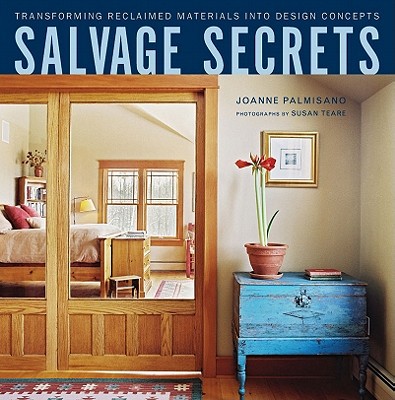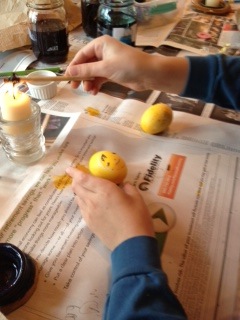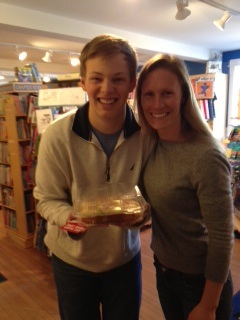I have finally gotten a chance to really look at the year-end numbers for book sales in 2011 as published in last week’s Children’s Bookshelf article: Facts and Figures 2012. I’m fascinated by the frontlist and backlist breakdowns.
The hardcover frontlist is chock full of sequels, fantasies, and young adult books. The dearth of picture books really surprised me. Just under 20% of the list were picture books, but in the backlist hardcover list, picture books comprised almost 60% of the top 104 bestselling books of last year. I have been puzzling over what these numbers mean to my store and my customers.
Clearly, sequels were all the rage. Books that folks were already familiar with populated the list. Almost 66% of the frontlist hardcovers were from a series. This tells me two things, which are sort of opposite sides of the same coin. The first is that folks weren’t taking many chances and trying brand-new things, or conversely, they so loved the earlier books that the sequels were met with glee. I think the numbers reflect a combination of both. The sequels last year were big and hugely anticipated, but I’m still taken aback by their total dominance. I have no data to back this theory up, but I think the frontlist bestsellers represent teens and preteens buying their own books, or at least dictating what books to buy.
It seems to me that the backlist hardcovers are leaning much more towards classics, perhaps the nature of backlist. These strike me as gifts for babies and could be the basis of a young person’s library. Dr. Seuss books and those by Margaret Wise Brown, Shel Silverstein and Sandra Boynton were heavily represented. I couldn’t help but think: baby showers. This is great news for booksellers. A backlist bestseller list that is so heavily titled toward picture books means lots of new readers. I am heartened by these numbers. The fact that Goodnight Moon sold over 500,000 board books means half a million babies got a classic and got started on the road to loving books. It’s our job to keep that road populated with great books, new and old. And what a fun job it is.
Easter Fun
Josie Leavitt - April 9, 2012
We don’t often close for a whole day, so when we try to take good advantage of the time off. Yesterday, our family gathered in Burlington for a lovely Easter
meal with our nephews, their friends and some folks from the neighborhood.
Elizabeth’s holiday tradition is to set up the dining room table for pysanky with egg dyes, wax
squares, kistkas (the stylus used to trace your design on your egg) and lots of newspaper and votive candles. Kids, who had been out in the yard with massive water guns, were quietly focused on their egg designs. The joy of the creation is always so much fun to watch. Laughter follows almost every dye bath. Often an egg is hard to get out of the dye bath and it can roll away, with a fair amount of speed. This year we used raw eggs, not hard-boiled, so the level of risk was heightened.
Every year, this day just makes me so very happy. The laughter sounds far after the eggs are done. “This egg is not taking color!” “My egg is cracked.” Is something burning?” The comments are just as funny as the rolling eggs. I hear, “Whoops” a lot. Sadly, sometimes I leave Easter and shake my head wondering why we don’t have more Sundays off. But, the eggs are beautiful and the leftovers are a great way to get through a Monday back at work.
“I Want to Live Here”
Josie Leavitt - April 6, 2012
Two lovely boys, ages seven and ten, came to the store yesterday and I wanted to clone them. They were enthusiastic readers and honestly, just some of the sweetest kids I’d had the pleasure of meeting.
Sadly, these kids were just visiting Vermont on their school break. They were with their family who make it a point to go from independent bookstore to independent bookstore while on vacation. They were the second family this week who were touring stores in New England. These families always make my day. Sloan, the teenage boy from Monday, is what these two little guys will grow up to be. Pure, happy book-lovers who could easily spend hours in a bookstore. Their is a patience that these kids have in bookstore that is so pleasant to see.
What charmed me the most about Johnny and David yesterday were their comments to their parents. I overheard several times from each of them, “I want to live here and read all the books!” When a ten-year-old states that he wants to live at the bookstore, you know you’ve done something right.
Over the years we’ve had many children say they want to live at the store. Readers of all ages are comforted by the possibility of being surrounded by books. But one young reader took her need to be with books farther than we had ever considered. When we were in an our old store, a very serious eight-year-old told us she wanted to be buried under the store in the crawl space.
Personally, I just want folks of all ages to feel comfortable in the store, in whatever way makes them happy, even if it’s a scary crawl space.
“He Won’t Read Books About Girls”
Elizabeth Bluemle - April 5, 2012
In her March 30 essay, On the Rules of Literary Fiction for Men and Women, in the New York Times, author Meg Wolitzer talks about perceived disparities in the evaluation and reception of fiction by men as opposed to women. Without getting mired in the debate — people get very uncomfortable very fast on the topic of gender discrepancies, disproportionately allocated awards and keynote speaking gigs, etc. — I will say that our culture does have some entrenched ideas (habits, really) about differences between men and women, and it affects our children from an early age. I know we’ve blogged about this before, but it’s a big issue and it’s not going away.
I’m not saying there aren’t differences between men and women, some hardwired and some culturally and environmentally acquired. But we do a huge disservice to our children and their ability to grow into compassionate, thoughtful, empathetic adults when we steer them away from things we think of as “belonging” to the other gender. If The Hunger Games had featured Katniss on the cover instead of a gold medallion against a black background, sales to boys would have been fractional. This is a frustrating truth. And it’s our fault. We steer kids—no, we steer boys—away from stories they might respond to from a very early age.
So often at the store, we hear parents say about a great book, “Oh, he won’t read that. It’s about a girl.” Really? By accepting and perpetuating, pandering to, this mindset, we are basically saying — to ourselves, each other, the boys, and most damagingly, to girls — that it’s okay not to have in interest in the experiences of HALF THE HUMAN RACE. I mean, it’s not even possible not to be interested in what half of the world does and says and thinks. And we wonder why there’s an empathy problem in our culture….
It’s true that many boys will resist books with girls on the cover. That’s partly because there is some undeniable difference in boys’ and girls’ interests (I’m certainly not suggesting that all boys will like all books about all girls). But it’s also partly because we train them from an early age to think that books about and for girls are not relevant or worthwhile to boys. I’m here to fly the flag of opposition to this and say, as you already know: a great story with fantastic characters will speak to readers across gender lines. We adults who put books into the hands of children can’t give in to the lazy, absurd pink/blue dichotomy that afflicts toys and baby clothes.
Forgive me if I’ve shared this anecdote before but I love it: I’ll never forget this sixth-grade boy from my school librarian days in New York City. Each class from second through eighth grade came into the library every day for a half hour of silent reading. They plucked their book from their class shelf, curled up in child-sized wicker chairs with cushions, and settled in to read. (To my mind, this daily reading diet remains the strongest, most effective literacy program I’ve ever seen in a school.) Anyhow, this boy—a typically masculine kid, smart, funny, popular with his classmates—had chosen Little Women as his book at one point. His male classmates tried to tease him unmercifully about reading what is inarguably the most femininely titled book in literary history, but he shrugged it off, utterly unconcerned. “You’re missing a great book,” he said dismissively, and buried his nose back in the adventures of Jo, Meg, Beth, Amy, and Laurie.
When Strangers Visit
Josie Leavitt - April 3, 2012
My store is in a small town in Vermont. There is no food except pizza that can be delivered to work. So yesterday was a lovely surprise.
A father and son came in and made our day. The son, Sloan, was looking at colleges with his very well read father. They were on a tour of a local college when they split from the group and sought out a bookstore. This is what they do when they travel. Their goal is to go all 50 states by the time Sloan is 18. They have 10 to go in a year. They also stop at bookstores in all states. And only indie bookstores.
I loved them. Kelly, my co-worker, and I, spent the better part of an hour recommending books to the Dad that we loved that he hadn’t read. It was almost like a contest. It felt like he had read everything. We went through all our favorites. The guy had read all of them. It was unreal: Dorothy Alison, yes. Christopher Moore, yes. Michael Chabon, of course; every Richard Russo book; even Gerald Durrell. Sloan was just as well-versed. They didn’t like mysteries, but were just as partial to women authors as men.
We switched gears and suddenly we found some books these guys hadn’t read. The Human Comedy, Ceremony, The Sherlockian, Never Let Me Go, Perfume and Unbroken, to name a few. Each book had to really be pitched. The man was fussy, but not in an irritating way. He was the kind of reader who can anticipate the moods he might be in for the rest of the trip and get books to complement them.
They had mentioned that they were going to Maine ostensibly to look at colleges, but really to have lobster. Kelly told them that real Mainers eat their lobster cold and they looked horrified. Both of them expressed their desire to eat hot lobster with lakes of melted butter. Kelly then told them where to get the best lobster roll – just up the street at the deli inside the local liquor store.
They left with three bags of books. We wished them well on their journey and I told Sloan that, should he come back to school at the University of Vermont, he should come back and say hello. He smiled broadly and left to drive to Maine with his dad. Or so we thought. Half an hour later, he returned with two lobster rolls for me and Kelly.
I’m not a fan of lobster, but I had a bite of the roll and I must say, it was delicious. In the whole time we’ve been open, only one other customer has brought me food, and her family owns a diner down the road. But never have first-time customers, in fact people who will likely never shop at the store again, gone out their way to bring us food.
What a lovely way to spend a Monday.
Another Reason Local Is Better
Josie Leavitt - April 2, 2012
I read with great interest a Seattle Times article on Sunday about Amazon. The article, “Amazon a Virtual No-Show in hometown philanthropy” (read article here), was posted by a friend on her Facebook page. To summarize: Amazon, a Seattle-based, massive corporation, gives practically nothing to Seattle-based not-for-profits.
While Jeff Bezos rightly claims that part of what Amazon does well is run a good for-profit business, which employs many people, there is no sense of urgency in sharing some its massive coffers with the less fortunate in Seattle. Bezos was quoted in the article about how he can best help the underprivileged by saying “Amazon’s e-book reader, the Kindle, might be seen as a low-cost, efficient way to distribute books worldwide to the underserved.” I couldn’t help but be struck by the inherent ill-logic of that statement. I might be naive, but I can’t help but wonder how many of the underserved book reading world have access to stable internet connections to download their books, oh yeah, and how are they going to pay for new books? I’m hoping at least the Kindles will pre-loaded with titles. But then there’s the pesky issue of electricity. Really, I could go on.
The overriding thing that struck me about this article is here is a company that brought in over 45 billion dollars (yes, that’s billion with a B last year) and has given next to nothing in its home base where it employs more than 9,000 people.
Every independent bookstore I know gives copiously not just to its community, but to many others. When Tropical Storm Irene devastated the southern part of Vermont we had several author events that were fundraisers for the Irene Fund, essentially ensuring that we made little or no money on those events. But we wanted to do more. Currently, we’re selling a book about Irene and the entire list price of that book goes to help rebuild homes destroyed in the flooding. Matt Bushlow of Vermont’s Children’s Literacy Foundation (CLiF) explains: “When the River Rose: Stories of a Vermont Town’s Flood, Recovery, and Rebirth, is a benefit for ReBuild Watebury, a nonprofit whose mission is to help residents in the Watebury area rebuild homes that were damaged or destroyed after the floods. 100% of the funds go to ReBuild Waterbury. No money at all goes to CLiF [or to The Flying Pig]. We created this project as a way to give back to our hometown. We coordinated the team that produced the book, and we have acted as its publisher. National Life Insurance Group donated most of the printing costs.”
This truly is a local effort bringing many organizations together to help benefit our neighbors.
In 2012 alone we have donated over $1,500 in books and gift certificates to more than 30 organizations ranging from the Boy and Girl Scouts to literacy organizations, the orchestra, the arts groups, the local women’s shelter, all the local libraries and just about any local class that’s raising money for its own charitable giving, etc. And we are not unique. All indies I know do this, and more in their towns. We do this not to curry favor with any one group (although having a Girl Scout come right to the store with a cookie order form is a lovely perk), but to support the people and causes we know.
Charitable giving is important, especially with the economy as shaky as it is. One of the reasons we will almost always give something to children who ask for a donation is so they learn at an early age that helping is what you do. Often the kids will come to us and ask for a gift card to go in a basket that they’re raffling off to raise money for a cause their class is supporting. So, we are helping them to help others and that’s a great thing. I can hear the skeptics out there saying, “But they’ll probably spend more than the amount of the gift certificate or that gift certificate won’t get redeemed.” To which I say, I can do nothing about that. That doesn’t change the fact that we’ve given x amount of money in books away. And as discussed last week (see our blog about gift certificates), 94% of our gift cards get redeemed, so we are giving away the products as intended.
We also participate in our communities by giving our time. We regularly do things with the schools. This Thursday Elizabeth will be reading picture books to the second graders during Racism Awareness week at the local school. Last week she read to the littlest kids at the Children’s Center pre-school because they asked if she would.
All indies host free-to-the-public author events that provide cultural enrichment to attendees. There is nothing more exciting for me as a bookseller than seeing the look on kids’ faces when they meet one of their favorite authors. Some kids start shaking, sometimes there are happy tears and always there is appreciation and thanks for our having brought this author to our town.
Again, the Flying Pig is not unique in this, I cannot say this enough: every independent bookstore does this. We support the people in our towns. Why? Because it’s the right thing to do. We don’t expect kudos for it, although thanks are always nice. We do it because we live where we work and we have relationships with the people and organizations that enrich our town.
So, the next time you’re looking a sponsor for your Little League team or for someone to take an ad in the community theatre program, remember who you ask, who happily says yes, and remember to shop there.
Getting Crafty at the Flying Pig
Josie Leavitt - March 30, 2012
Last night we hosted our first-ever craft event for adults. DIY expert Joanne Palmisano, who has a great new book out, Salvage Secrets:  Transforming Reclaimed Material into Design Concept, led the activity. We decoupaged old lamps and made them into something delightfully stylish and lovely. I had never decoupaged anything, in fact I had to look up what it meant. It means to decorate something by glueing paper cutouts on it. It sounds simple and is actually really easy and so transformative. Let’s face it, some of the lamps we started with weren’t beauties, but by the end, they were really great looking.
Transforming Reclaimed Material into Design Concept, led the activity. We decoupaged old lamps and made them into something delightfully stylish and lovely. I had never decoupaged anything, in fact I had to look up what it meant. It means to decorate something by glueing paper cutouts on it. It sounds simple and is actually really easy and so transformative. Let’s face it, some of the lamps we started with weren’t beauties, but by the end, they were really great looking.
Joanne brought all the supplies we needed, from the lamps, to the glue, to the really cool wrapping paper (a great way to spiff up a lamp and relatively inexpensive) and even an old dictionary. Joanne’s intern spent much of the week going to every Goodwill, Salvation Army and recycle place to find the 20 lamps we needed. They may not look like much, but by the time we were done, they had been transformed. Joanne was an excellent teacher and folks were put at ease right away.
cool wrapping paper (a great way to spiff up a lamp and relatively inexpensive) and even an old dictionary. Joanne’s intern spent much of the week going to every Goodwill, Salvation Army and recycle place to find the 20 lamps we needed. They may not look like much, but by the time we were done, they had been transformed. Joanne was an excellent teacher and folks were put at ease right away.
Folks, all women and including two sets of mothers and daughters, each picked out their lamps. The cutest thing was both moms and daughters choose matching lamps that were pink with one large lamp and one small lamp. I am not a crafty person. I’m not good with scissors or glue, so I really just watched this event. People were so happy. The whole room was full of joyfully concentrating people and this is not something I see every day. All the lamps were different and clearly reflected the decoupager. It sort of amazed me what glue, paper and scissors was doing for the moods of all involved. I glimpsed a tiny bit of what if must be like to be crafty and be able to make beautiful things from humble beginnings.
I was struck also by the eagerness the women had for us to sponsor more events like this. Joanne had her very good friend, Shannon Quimby, another DIY expert, with her. The two of them see old things as a challenge. I see an old beat up suitcase, Shannon sees a dog bed. Joanne sees a truly ugly lamp and can envision it as a stunning lamp with very little effort. Their enthusiasm for turning the not-so-beautiful into beautiful was infectious. People were brainstorming other things we could do, like make picture frames and holiday ornaments from scraps and buttons.

The finished lamps were really quite remarkable. The lamp at the right was painstakingly done by an eight-year-old who cut individual flower petals from the gift wrap she chose. Joanne said that while tearing the paper might seem easier, it leaves a white edge, so everyone shared the seven pairs of scissors we managed to scrap together. In the end, the lamps were shellacked and ready to go home with their creators. People knew exactly where they would go and Joanne told everyone where to go to buy matching shades.
So often we don’t create anything in the modern world. We listen, we absorb, we surf the internet, but I’ve never had a store event where folks walked away with something they could use for the rest of their lives in their homes. There was something alien about this as I’m not someone who thinks about creating these things. It was lovely to see all these happy faces creating their beautiful lamps and feeling really good about taking something that might have been thrown away and making it into something they were proud of and couldn’t wait to display in their houses.
A Peek Inside ‘The Hunger Games’ with Movie Producer Jon Kilik
Elizabeth Bluemle - March 29, 2012
We may live in a small state, but big things do happen here. On Sunday, we had the opportunity to sit in on a Q&A session with Hunger Games movie producer, Jon Kilik, who who addressed everything from why the Cornucopia is gray instead of gold to (sort of) why Peeta didn’t lose his leg.
Kilik graduated from the University of Vermont in the 1970s and still has strong ties to the community. He spoke to two groups of moviegoers at special ticketed showings at the Williston, Vt. Majestic 10 movie theater after the screenings. (To make the $20 ticket fee even more worthwhile, the event was a fundraising effort for the UVM Film and Television Studies Department, in memory of a beloved professor, Lucille Jarvis, and it raised about $5,000.)
Before the Q&A, we hadn’t realized just how impressive and varied is Mr. Kilik’s resume. He’s produced some of the most provocative, beautifully made, unconventional films of the past 25 years, including Do the Right Thing, Malcolm X, Dead Man Walking, Basquiat, Pleasantville, The Diving Bell and the Butterfly, Berlin, the upcoming The Comedian, and many more. He’s got nearly 40 films to his credit, from comedies to intense dramas to documentaries. His interest in telling true stories both faithfully and dramatically helps explain why The Hunger Games stays so close to the book. (Also helpful, of course, was Suzanne Collins’s role — she’s an industry veteran — as screenwriter and executive producer.)
What follows is as close a verbatim accounting of some of the questions and answers as my thumbs could manage on my iPhone. My fingers were flying! The audience members came up with some terrific questions, and I was impressed by Mr. Kilik’s thoughtful, good-humored responses. He was wonderful. I’ve paraphrased anything I wasn’t able to quote exactly, so you’ll be able to distinguish between what he actually said (in quotes) and what I took away from what he said (not in quotes). Often, he said much more during a response than I could capture. It was a treasure of an opportunity for someone who loves both books and film, and I’m still aglow at having been there.
For a more proper interview (and there are many out there!), check out this one in Vermont’s arts weekly, Seven Days.
Q: You’ve never made this kind of movie before [not sure if the questioner meant a movie for kids, or a dystopian action film]. Why did you decide to do this one?
Kilik: “I saw it as a future that we’re almost in today.” [He likened the story to life in high school, and spoke of its relevance to our society today.] “Although it takes place in the future, it’s not really science fiction. It’s allegory for our times. If it were just fantasy, I don’t think [the huge popular response to the story] would be the thing that it is today.”
Q: “How do you keep the audience from being complicit in the killing of the other characters?”
Kilik: “That’s the challenge of making this film. The author had a father who was in Vietnam when she was 12, and she had nightmares about not knowing where he was or whether he was alive. Suzanne Collins wrote this with that memory, and today watching the war in Iraq and in Afghanistan and then flipping channels to a TV show like Survivor, they all started blending together and she wanted to address that. It’s the fog of war, the nightmare of what it could be like. She was, like David Lean, trying to write an anti-war movie.”
[One audience member had used the phrase “survival story” when asking a question of UVM professor emeritus Frank Manchel, who introduced Jon Kilik. Kilik picked up on that.] “Yes, I’m glad you used that word, ‘survival.’ The Hunger Games is about survival, not killing. I think that’s an important distinction when talking about the story.”
Q: Will there be a second movie?
Kilik: “It will happen. I hope it gets made by the same group who made this one happen. The Hunger Games was made like a little indie film. We made the movie without any interference. [He spoke about how many studios had turned down the movie, thinking it was untenable because of the violent premise, and how Lionsgate, who bought it, really let them have free rein because the expectations for success were low.] “It was like dancing through the raindrops. Now that it’s a hit, a lot of people are going to want to get involved and try to be smarter than we were, and as you know, that’s always a disaster.”
Q: How did the book get in your hands?
Kilik: “[Hunger Games director] Gary Ross has two 16-year -old twins who told him about this book.” [There was a lot more here about how they rely on enthusiasm and suggestions from kid readers in their families, and in friends’ families. Yay, kids!]
Q: How did you get to be the ones to make the movie?
Kilik: “There were other directors that the studio who had the rights to it had a list of, but Gary was very aggressive about it.” He spoke about how much they wanted to do it, and how persistence and a good plan won out.
Q: How did you feel about the actors?
[Kilik was very enthusiastic and warm about the entire cast; I couldn’t type fast enough to catch it all. After many accolades for Jennifer Lawrence, who plays Katniss, he had some special words about the actor who plays Peeta.] Kilik: “In addition to Jennifer Lawrence—who carried the movie on her back — Josh Hutcherson is our secret weapon, the heart and soul….”
Q: The movie stayed really close to the book, which doesn’t always happen. Why did you decide to do that when so many Hollywood movies don’t?
Kilik: “I’m always trying to find the most honest way to make the film. Follow the road that the author has set up for you and stay close. Follow that truth. And these are just great actors, too.”
Q: Why did you decide not to have the dead tributes in the muttations?
Kilik: “We were trying to make the movie as real as possible, not to take you out of the movie. It was starting to feel like something that was too big. It would have opened up a whole other set of questions. It’s the end of the movie; it’s got to end without opening up a whole lot of other questions. Did you miss it?”
Q: [pause for thought] I just noticed it.
Q: Why didn’t Peeta lose his leg in the movie?
[I was so distracted by trying to remember how much we knew about Peeta’s leg having been mauled by the muttations and subsequently amputated and replaced with an artificial limb, and when we knew it—that I can only paraphrase Kilik’s response. He basically said that they had made some decisions about that that would affect the subsequent movies.]
Q: The scene with Snow and Seneca Crane in the garden wasn’t in the book. How did you think of that?
Kilik: “There was a little bit of creative license. If we stayed to exactly what was in the book, it might have gotten boring. We wanted to define the antagonist a little more, and give the audience different settings like the Game Center and the rose garden scene. And that gives you a little more character development.”
Q: The book had so many of Katniss’s thoughts. I wondered how you were going to do that, whether you were going to use voice-over, but you didn’t do that. How did you make us know what she was thinking?

Dark theater + iPhone + distance = this photo. Apologies. (We were actually much farther away than the photo indicates.
Kilik: “The book is very much first person; it stays in Katniss ‘s head. When you see it, it’s very first-person narrating style and editing style – you are really in her shoes. We kept pushing the camera into the actors until it felt real. You’re really in her face constantly. It’s very visceral. She’s got such great expression that even without the sound on you can see what she’s feeling.”
Q: Why did you change the way Katniss got the mockingjay pin?
Kilik: [Acknowledges that this was one of the changes they talked a lot about with Suzanne and the other writers and producers. In the end, he said, they just went for a certain kind of storytelling efficiency.] “The movie’s two hours and 20 minutes; we wanted to keep it tight and not introduce a lot of extra characters. [He talked a little more about these kinds of changes.] “Knowing how many fans there were of the book; the fear of getting it right when you respect the material and want to do the best with it and if you just miss by a little bit it’s going to be a problem.”
Q: In the book, the Cornucopia is gold, but in the movie, it’s gray. Why?
Kilik: [laughs, nods] “It would have been nice golden, but it was the type of metal we had to work with…. Yeah. It might have been nice a different color.”
Q (this is the one I asked): In the midnight showing on Thursday, there were lots of younger kids, nine and ten years old, in the audience. In that showing, there were cheers when some of the ‘enemy’ Tributes were killed. I was hoping there would be some conversations in the car on the way home, but what would you say to those younger kids who are watching the movie to help keep the larger themes in mind?
Because I had asked the question, I didn’t want to be rude and look down at my phone, typing, while he answered, so unfortunately I don’t have any verbatim quotes on this question. He spoke again about its anti-war message, and the fact that it’s a story about survival, and that kids are rooting for Katniss and Peeta and are seeing the other Tributes as the enemy in that context. That it’s a war, and that’s what war does. I was a little disappointed that he didn’t really address the question of what age kid should be going to see this movie, but the question that came right after mine, from a little girl around seven or eight in the row behind me, answered that one pretty definitely.
Q: I was wondering, how did the kids get hurt in the movie but not in real life? I didn’t understand how that happened.
[And that really says it all about how old an audience member should be to see this film. There was a collective audience gasp and “awww/ohhhhhh” of realization at this. It was heartbreaking and exactly that bucket of cold clear water people who get caught up in national trends need to keep in mind. Children have gaps in experience and knowledge and development, some of which don’t even occur to us. I fervently hope parents will pay attention, talk to their kids about this stuff, and not just get swept away by the “everybody’s going to this movie!” mentality. Argh.]
Kilik: “That’s the magic of movies. It’s make-up and special effects.”
In a way, it was the most appropriate possible question to end the Q&A. I’m sure there was a lot of conversation in that family’s car on the way home, both about special effects, and about the meaning of a movie meant to excoriate war by showing war. And for those of us in the bookselling and movie industries, selling a story to children, it keeps fresh that all-too-easily blurred line where content and commerce collide.
A Gift Certificate Conundrum
Josie Leavitt - March 28, 2012
We issue gift certificates, like almost every other store in the country. Yesterday there was a customer exchange that made me think very hard about my policies and how flexible (or not) I should be.
A customer came in while I was at lunch and explained to my very patient staffer that in 2005 she was given a notecard from her students saying there was a gift certificate waiting for her at the Flying Pig. She never came in to claim the certificate. This was back before we switched to the ABA-sponsored gift card programs; the certificate was paper and we held it in the desk drawer for her for a full year and a half until we moved the store. Back then these certificates expired in a year, which was clearly written on the certificate. We always allowed them to be redeemed up to three years later. This three-year time span is now the law.
Now, seven years later, the teacher comes in with the original card, but no actual paper certificate, which we show as having been written and possibly picked up.
My initial inclination was to tell the customer that the gift certificate had long expired and could not be used. But I posted this situation on the New England Children’s Bookselling Advisory listserv and was frankly stunned by the number of folks who said they’d accept the gift certificate, even though there was no actual certificate and it was seven years old.
I was so torn about this. In a perfect world, I’d happily accept on faith that we had held a gift certificate for a teacher seven years ago and just let her use it. Perhaps it’s the sudden dip back into winter this week, but I’m tired of being taken for granted. It has cost me money to have my accountant keep carrying this unused gift certificate on my books. I know we received money for this, I’m not disputing that, but there are rules for things.
Things expire and are no longer good. If I can accept that when I clean out my car and find an expired gift certificate for a restaurant, why can’t my customers? Why should I bend the rules, the very clear rules, for one customer? But then I hear the voice of customer service, that says, just let her use it and move on.
I was reminded anew of that statistic that retailers hear: when a person has a good experience they tell three people, when they’ve had a bad experience, they tell twelve. This weighed heavily on me as I tried to make a decision that felt fair to both of us. Elizabeth and I decided in the end to issued the customer a gift certificate for half the original amount. This seems really fair to me. If that mythical restaurant honored any part of my expired gift certificate I’d be thrilled.
The customer didn’t thank me, nor did she acknowledge that we were doing her a favor and honestly, going above and beyond. She wanted to have us hold the gift card for her behind the register. I popped it in the mail instead.
Credit Squeeze, Or Isn’t Paying the Bill On Time Enough?
Josie Leavitt - March 26, 2012
I know times are tough for all the publishing companies, with Borders closing and leaving them hanging for payments for a long time. Every store that closes affects publishers’ bottom lines in profound ways. But I’ve had it with publishers basically threatening me to pay before the bill is due or not applying my credits.
I received an email from a publisher (which I will not name, as no one from the company has gotten back to me on my short time frame) that essentially said, pay what’s due for March 31st now, or we will not ship your books.
Here is the email: Payment has been received to clear the invoices due 2/29/12 but not the 3/30/12 due. Please provide payment details for the current due invoices as soon as possible. Shipments remain suspended until the account is fully up to date.
I received this email on March 22, more than a full week before the payment of $877 was actually due. So, to summarize, my account is fully up to date, I owe nothing, and yet this publisher is not shipping any orders and is treating me like I’m late to pay my bill.
I hate this kind of business tactic. I want to say to this publisher: how about the benefit of the doubt? I’m not even late and yet, you’re acting like I’m 90 days late and I’m seldom late more than a day or two. But if the check isn’t in the lock box by the last of the month, this company puts any bookstore on credit hold and refuses to ship my books. What kills me is I get these nasty little emails every month, although this one was overt in saying no books will ship until they get payment details. Usually, the emails just serve as reminders that the payments are expected. In February, I even got one reminding me that it was a short month and I should adjust my check accordingly.
I know these credit reps are just doing as they’re told, but this utter lack of faith is destroying my relationship with certain publishers. I tire of being considered a deadbeat when I’ve done nothing wrong. I am weary of wondering if the books I’ve ordered will ship if the check is 24 hours late.
Oh, and don’t get me started about the publishers who won’t apply credits without monthly written approval from me. So, monthly, I write emails (some, though, need to be faxed) saying please apply my credits to my outstanding balance. Why do I need to do this? Shouldn’t it be obvious I want the credits applied, especially since the credits are based on returns that I sent in?
Why are publishers making it harder and harder to do business? Every meeting with reps has them asking, pleading in some cases, to order more backlist, but why am I going to subject myself to being treated like a deadbeat on a monthly basis for payments that aren’t even late? Ironically, the smaller publishing companies are the most relaxed about payments, even though they’re the ones who can least afford it.
It’s a tough market for all of involved with bookselling. Publishers are out thousands, millions of dollars in some cases, and bookstores are struggling with tighter margins and a shrinking customer base. Without sounding trite I can’t help but think: Why can’t we all get along?






